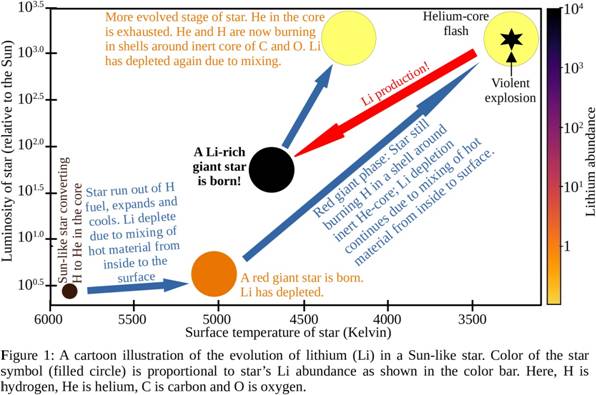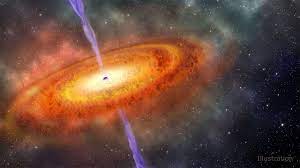Scientists have found a clue to the mystery behind the high abundance of Lithium— a trace element on Earth, and a key component of rechargeable batteries, in some evolved stars.
For more than four decades, Astronomers have known that a class of stars have an anomalous amount of Lithium on their surface. The reason and processes behind the high abundance of Lithium in about one percent red giants has remained a puzzle since the models of how stars evolve predict the Lithium must have been destroyed in the hot plasma of the star.
Mr. Deepak from the Indian Institute of Astrophysics (IIA) Bangalore, an autonomous institute of the Department of Science & Technology (DST), Government of India and Professor Emeritus David L. Lambert from the University of Texas at Austin and an Honorary Fellow of IIA Bangalore have for the first time confirmed that all the lithium-rich stars are burning helium in their core. They speculated in their paper published in the journal MNRAS that lithium production is linked to the violent helium-core flash.
“About four decades ago, a red giant with extraordinarily high lithium abundance at its surface was discovered. In all other respects, this red giant was of normal composition. Early follow-up investigation of lithium among red giants showed that just about one percent of sun-like red giants had a lithium-enriched surface. The questions on processes that led to a 100-fold or so increase in the lithium abundance in this exceptional red giant and reason behind this selective enrichment of lithium in the one percent of red giants intrigued us,” Deepak explains.
The authors drew on a large survey of the compositions of red giants undertaken in Australia at the Australian National University with observations gathered by on the 3.9 m Anglo-Australian Telescope at the Australian Astrophysical Observatory. The survey GALAH – named after a common Australian bird — provided a collection of about 500,000 stars with well-determined physical and chemical properties, including lithium abundances.
To find if the enrichment of lithium in red giants favours any particular mass and metallicity, they separated GALAH’s stars into different mass and metallicity ranges and then searched for lithium-rich giants among these groups. This exercise, done for the first time on such a large scale and across a wide range of mass and metallicity, reveals the rare presence of lithium-rich giants in all the Sun-like low-mass stars.
They created virtual stars of various masses and metallicity and compared the properties of these virtual stars with that of real stars from the GALAH survey. These comparisons confirmed that all the lithium-rich stars are burning helium in their core.
In a separate study, the researchers combined information about oscillations in stars’ interiors with their lithium abundances to find the origin of lithium-rich giant stars. For this study, they collected astero-seismic data (i.e., information about oscillations in stars’ interiors) for giant stars with measured lithium abundances. They found that all the lithium-rich giant stars are burning helium in their core.
Years ago, nuclear astrophysicists proposed a simple and short sequence of nuclear reactions involving a collision between the two stable helium isotopes which led to a stable lithium isotope. This reaction is supposed to occur during the initial violent ignition of helium-burning in the hydrogen-depleted core just prior to the onset of stable helium burning in the red giant. The authors adopt this idea and call for theoretical astrophysicists interested in the interior structure of red giants to provide quantitative estimates of lithium production during the ignition of helium burning in red giants.

Publication details:
1) Deepak and David L. Lambert (2021), MNRAS, Volume 507, Issue 1, pp.205–224, https://doi.org/10.1093/mnras/stab2022
2) Deepak and David L. Lambert (2021), MNRAS, Volume 505, Issue 1, pp. 642–648, https://academic.oup.com/mnras/article/505/1/642/6256853
For more details, Mr. Deepak (deepak@iiap.res.in) and Professor Lambert (dll@astro.as.utexas.edu) can be contacted.
 Indian Industry Plus A Pratisrutiplus Suppliment
Indian Industry Plus A Pratisrutiplus Suppliment


















